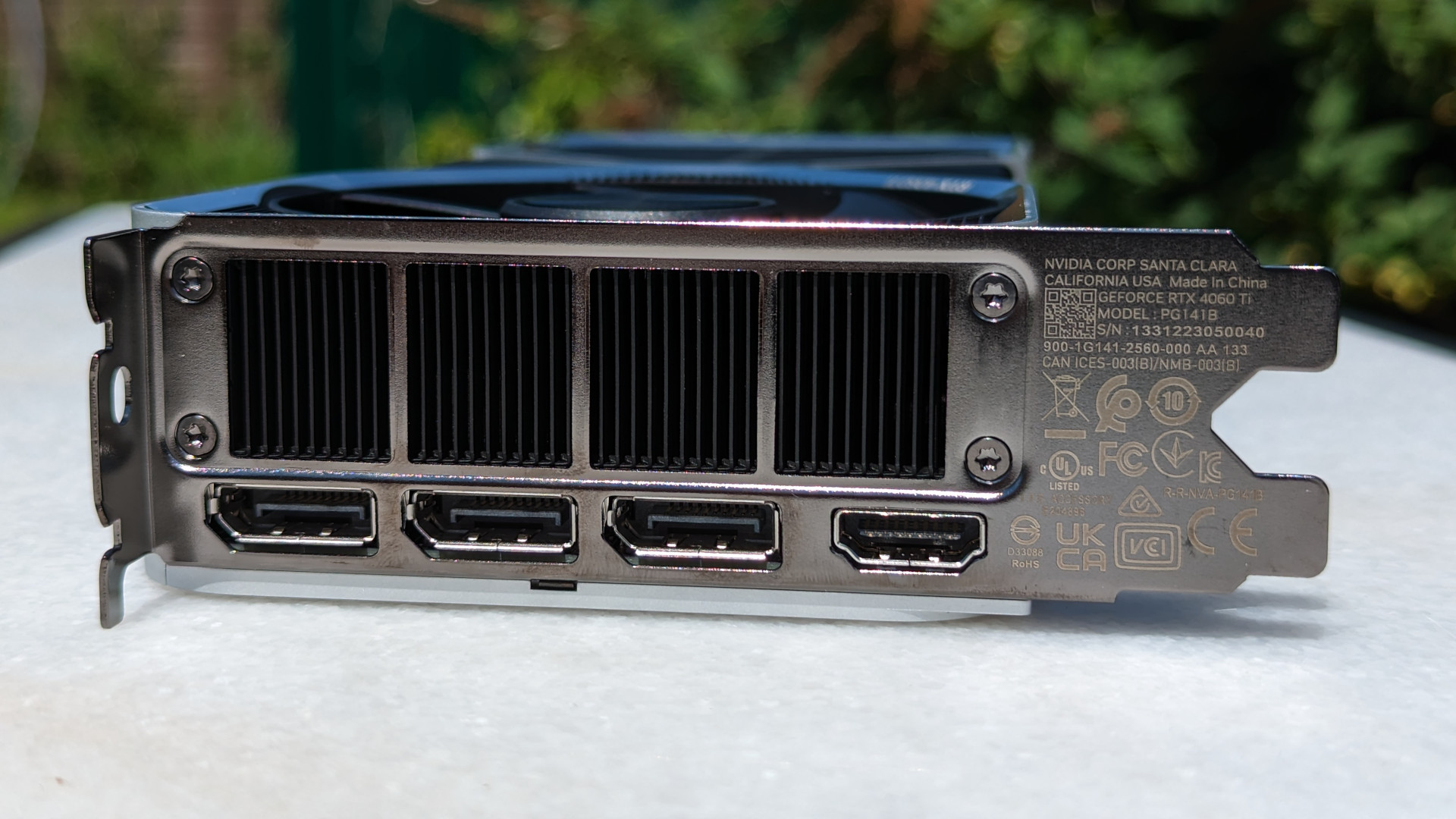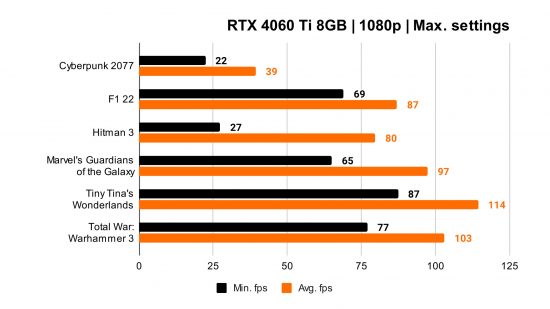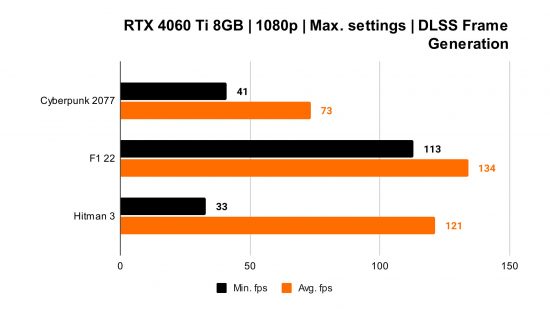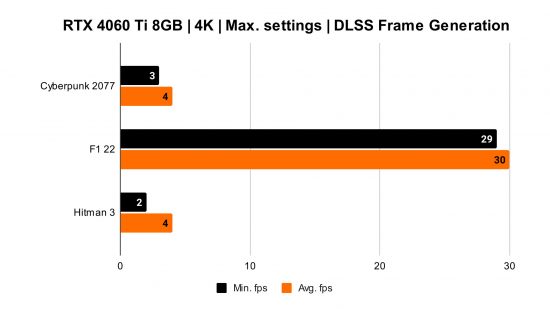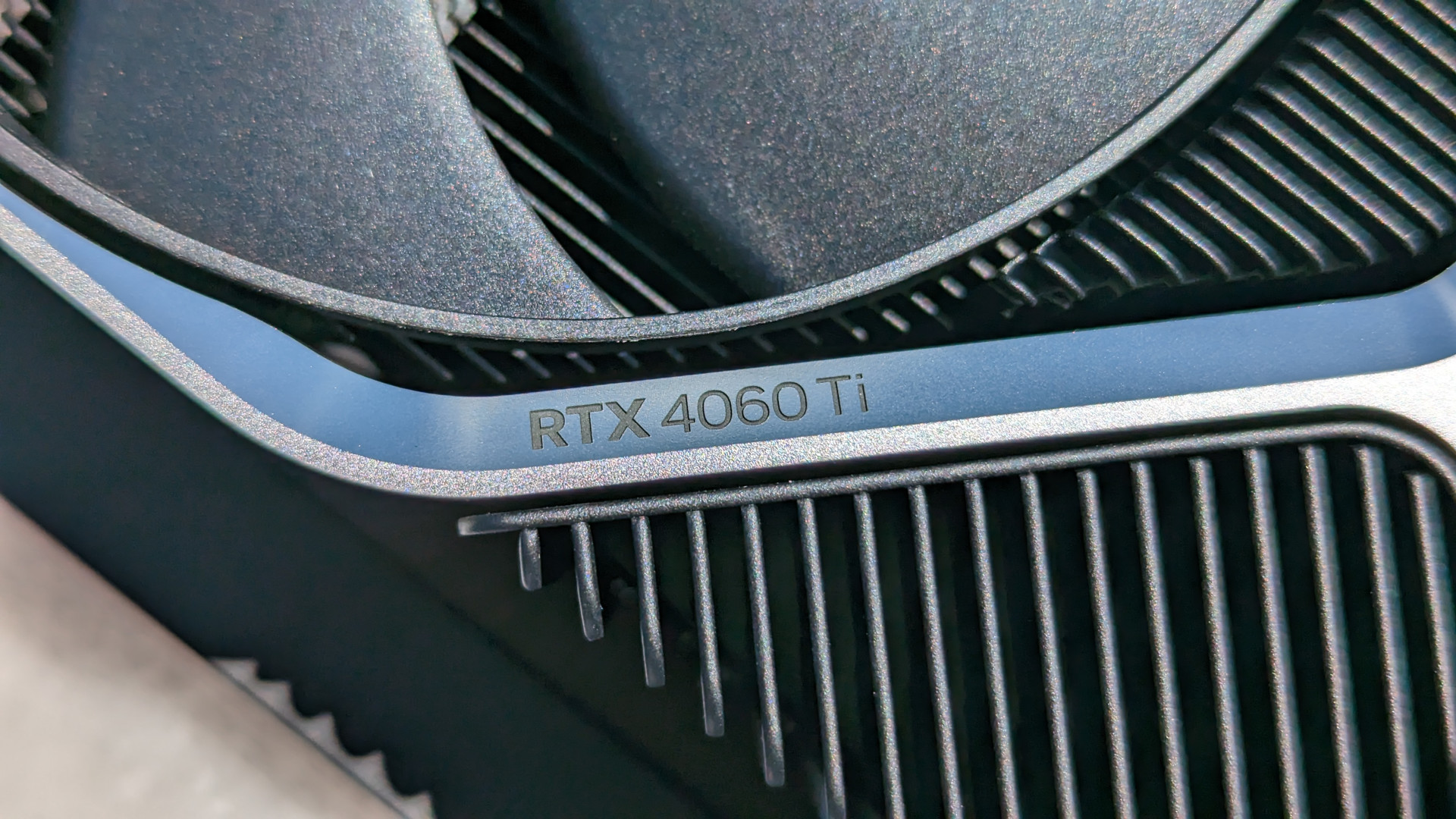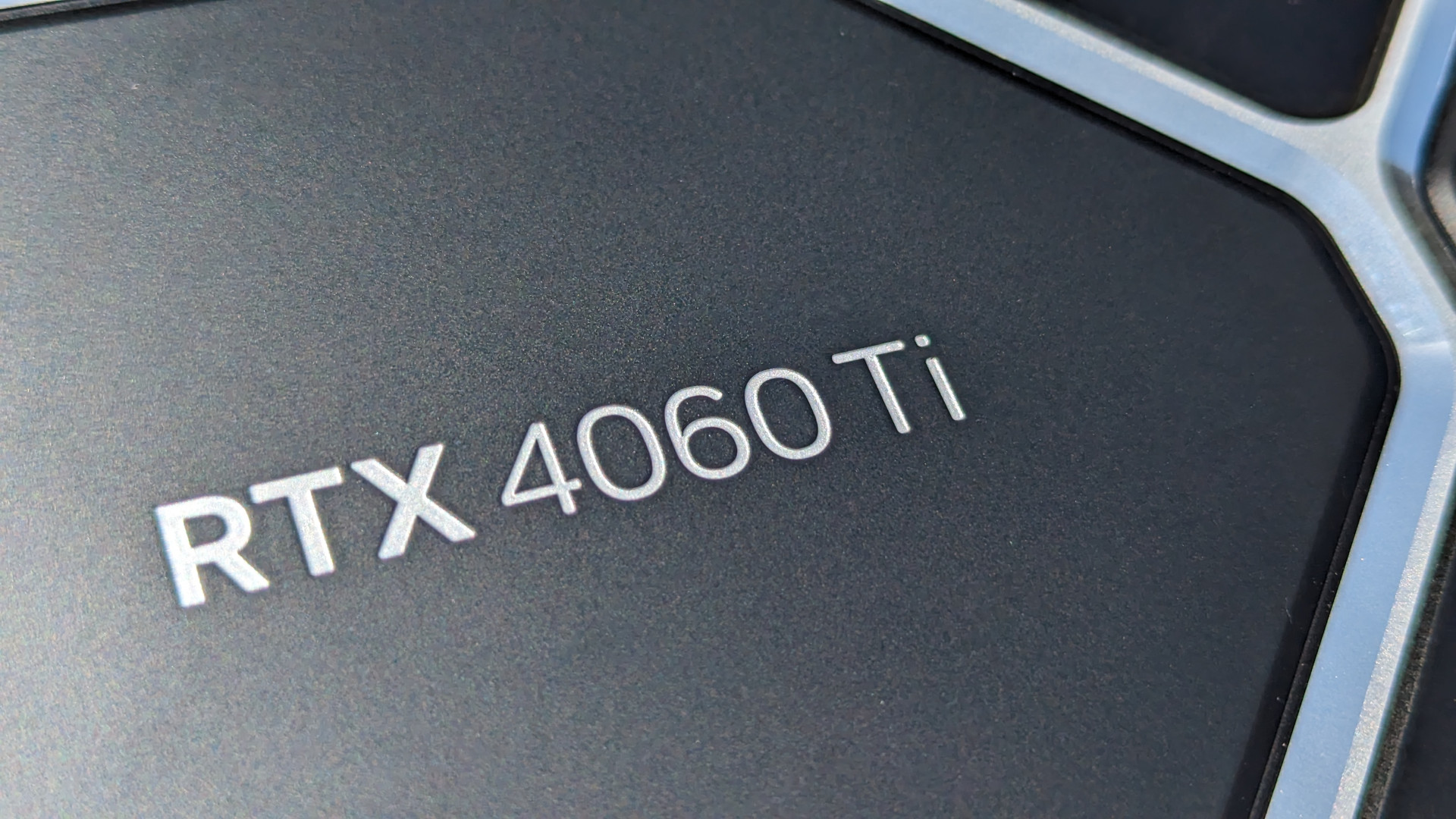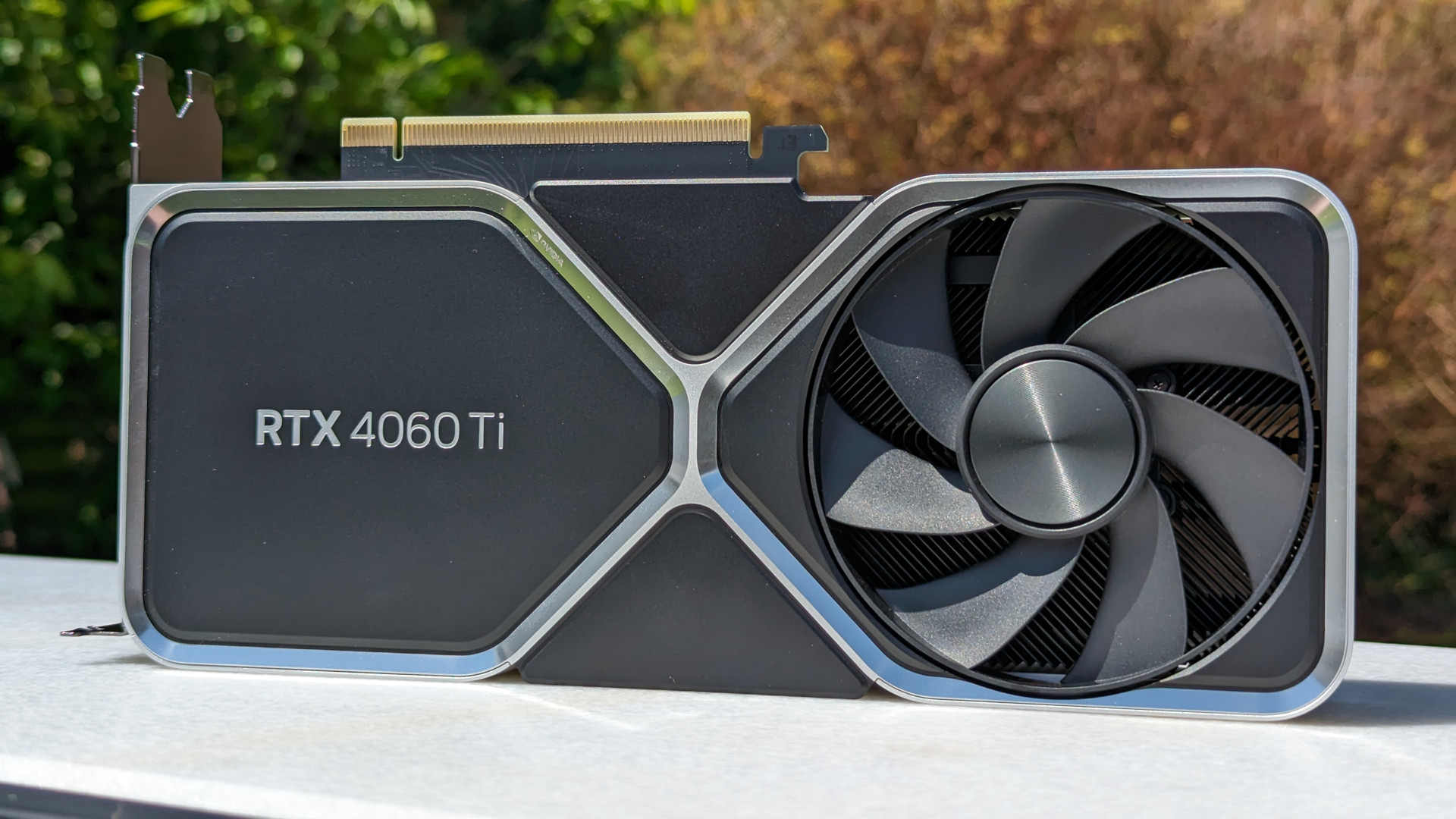Our Verdict
The silicon in the Nvidia GeForce RTX 4060 Ti 8GB feels massively letdown by its measly VRAM capacity, leaving greater performance and future proofing prospects on the table.
I feel conflicted writing this Nvidia GeForce RTX 4060 Ti review. As expected, this graphics card offers greater levels of performance compared to the RTX 3060 Ti and 2060 Super and boasts a more robust feature set, complete with DLSS Frame Generation. However, there’s an eight gigabyte sized elephant in the room looming over this GPU that gives me concerns of its staying power.
At the time of writing, the RTX 4060 Ti 8GB is the only GPU from its family to have been released, with the 16GB model and vanilla RTX 4060 due to launch in July. Right now, it’s hard to say which will be the best graphics card for those looking to maximize value above all else. With that in mind, I’d strongly recommend waiting until the full stack arrives before splashing $400, if you can help it. For those of you keen to pick up a pixel pusher now, here we go.
To help you get to the part of the review you’re most interested in, click on one of these handy links to go right to that section:
Nvidia GeForce RTX 4060 Ti specs
As its name suggests, the Nvidia GeForce RTX 4060 Ti 8GB features 8GB of GDDR6 VRAM, but is otherwise identical to its upcoming 16GB sibling. The eagle-eyed among you will note that this is the first RTX 40-series GPU to pack this amount and type of memory, but that’s not the only spec difference separating the graphics card from the RTX 4070.
Here are the Nvidia GeForce RTX 4060 Ti 8GB specs:
| Nvidia GeForce RTX 4060 Ti 8GB specs | |
| GPU | AD106 |
| CUDA cores | 4,352 |
| Tensor cores | 136 (Fourth Gen.) |
| RT cores | 34 (Third Gen.) |
| Base clock | 2,310MHz (2.31GHz) |
| Boost clock | 2,535MHz (2.54GHz) |
| VRAM | 8GB GDDR6 |
| Bus width |
128-bit |
| TGP | 160W |
| MSRP | $399 / £389 |
Credit where it’s due, I’m glad to see Nvidia offering some value here with the RTX 4060 Ti 8GB boasting 74% of its bigger brother’s CUDA, Tensor, and RT cores for 33% less. It’s also more power efficient too, with a TGP of just 160W, meaning you only need a single 8-pin PCIe connector to power this GPU up (PCIe Gen 5 adapter notwithstanding).
The biggest tradeoffs come back around to memory bandwidth and capacity. To combat the shortcomings of a 128-bit memory bus, Nvidia has given the RTX 4060 Ti 8GB more L2 cache, 32MB to be exact, to keep VRAM traffic down. The company claims this gives the card a relative performance boost, versus 8MB, in the region of 15-35% depending on whether ray tracing and DLSS are enabled.
Nvidia GeForce RTX 4060 Ti size and design
Our Founders Edition RTX 4060 Ti 8GB sample is basically identical to the RTX 4070 in sizs and design, save for the name plastered on the back of the GPU. It’s a dual-slot form factor that’s just as long but slightly slimmer than the next GeForce GPU in the stack, which is both attractive and practical both in and outside a PC case.
While the RTX 4060 Ti 8GB may be skinnier than the RTX 4070, it still manages to stay just as cool, with temperatures peaking at 70°C under load. As with other Founders Edition cards we’ve tested, there was no audible coil whine at high frame rates, either. Display inputs remain the same as ever, too, with a single HDMI 2.1 port and three DisplayPort 1.4 ports.
Truth be told, I’m most excited to see dinky dual-fan and single-fan RTX 4060 Ti 8GB graphics cards, thanks to its thermal headroom and welcome power efficiency. Much as the chonky champion that is the RTX 4090 impresses me with its size and performance, I’d love to see a small sleeper build that supports DLSS Frame Generation.
Nvidia GeForce RTX 4060 Ti benchmarks
In my Nvidia GeForce RTX 4060 Ti 8GB benchmarks, I’ve collected frame rate data for native 1080p, 1440p, and 4K resolutions. I also ran DLSS Frame Generation tests separately. Each benchmark was run three times to produce an average result, using the game’s highest quality preset including any additional ray tracing options.
Here are the specs of my test system:
- GPU: Nvidia GeForce RTX 4060 Ti 8GB Founders Edition
- Driver: GeForce Game Ready version 531.93
- OS: Windows 11 Pro 22H2 (22621.1702)
- Motherboard: Asus TUF Gaming X670E-Plus (BIOS version 1413)
- CPU: AMD Ryzen 7 7800X3D
- RAM: Corsair Vengeance 32GB (2 x 16GB) DDR5 6,000MHz
- SSD: WD_Black SN850X
- PSU: Corsair RMx SHIFT Series 1000W
I would like to note that my Cyberpunk 2077 benchmarks were conducted with some pre-release files that aim to resolve incompatibilities with Ryzen 7000 series processors and DLSS Frame Generation. Nvidia tells PCGamesN that they will be made widely available in an upcoming update for the game, as well as The Witcher 3.
Nvidia GeForce RTX 4060 Ti performance
Nvidia bills the RTX 4060 Ti 8GB and its wider family as best suited for 1080p gaming, but the pixel pusher is somewhat capable of pushing out playable frame rates at 1440p too. When it comes to 4K, though, things get single-digit ugly.
Cyberpunk 2077 is the only game in our test suite that sees the RTX 4060 Ti 8GB pump out fewer than 80 frames per second plus on average, making for a solid first impression. Minimum frame rates are similarly great too, ranging between 65-77fps, save for the 22-27fps we see in Hitman 3 and CD Projekt Red’s performance-heavy RPG.
DLSS Frame Generation helps boost fps and alleviate GPU bottlenecks to frankly staggering degrees at 1080p. The feature transforms the feel of Cyberpunk 2077 on the RTX 4060 Ti 8GB, increasing minimum and average frame rates by 86% to 41fps and 73fps, respectively. F1 22 and Hitman 3 enjoy sizeable bumps too, but Nvidia’s AI tech can’t seem to give Agent 47 a marked increase when it comes to 1% lows.
I should note, however, that Nvidia itself has coyly admitted that some games’ maximum settings can prove to be too much for the RTX 4060 Ti 8GB, even at 1080p. After some first-hand testing with A Plague Tale: Requiem, I can confirm this is unfortunately the case and a black mark against the GPU. Frame rates in demanding areas initially appeared stable, but quickly began to stutter before descending into a permanent slideshow. Sliding down to a lower preset alleviates this, but it’s a damn shame to see the more than capable silicon held back like this.
1440p stretches the RTX 4060 Ti 8GB further, and it’s here that we see VRAM easily saturated at higher settings. To be clear, the GPU can still produce very playable frame rates, especially with DLSS Frame Generation enabled, but this will vary from game to game. That said, I am keen to see how the 16GB model compares to reveal how much this silicon is being held back by its 8GB of memory and how much performance that extra $100 buys.
As expected, the RTX 4060 Ti 8GB isn’t up to the task of playing most games at 4K. Strangely, however, DLSS Frame Generation appears to make frame rates worse in Cyberpunk 2077 and Hitman 3. Meanwhile, F1 22 appears to hit a ceiling of sorts and can’t go faster than 30fps.
Nvidia GeForce RTX 4060 Ti price
The RTX 4060 Ti 8GB is the first of Nvidia’s RTX 40-series GPUs to match the cost of its predecessor, at $399, with the rest of the stack commanding a higher generational price. This is a welcome change, if not an overdue one.
Right now, the only current rival facing off against the RTX 4060 Ti 8GB is the Intel Arc A770. The 16GB version of the Alchemist graphics card is $50 cheaper, $349, with the 8GB model available for even less at $329. However, the GPU offers RTX 3060 level performance and lacks DLSS Frame Generation, and a history of driver instabilities stop me from outright recommending it despite Intel’s praiseworthy efforts to improve them.
Last-generation offerings and the used market are always worth a look, but you’ll want to act fast if you want to snatch up an RTX 30-series or AMD Radeon RX 6000 series pixel pusher, as stock is quickly drying up.
Given we know the RTX 4060 and RTX 4060 Ti 16GB are coming, with a heavily rumored AMD Radeon RX 7600 presumably not far behind, it’s hard to truly assess the value the RTX 4060 Ti 8GB presents. If you absolutely need the cheapest current-generation GPU you can get right now, then it’s your only option, and it should be up to the task of 1080p gaming with some caveats.
That said, it’ll be worth waiting a little while longer to see how other options fare in terms of immediate and longstanding value. Again, I’m particularly keen to see how the RTX 4060 Ti 16GB fares.
Is the Nvidia GeForce RTX 4060 Ti worth it?
The RTX 4060 Ti 8GB is one of the more complicated GPU launches I can remember in recent memory. Generally, I’m happy with the level of performance it offers for the price it commands when its VRAM, or lack thereof, doesn’t get in the way. However, when it does, it can result in frame rates that are utterly unacceptable.
It feels as though Nvidia has made a misstep in not giving this graphics card at least 12GB of VRAM, which would be much easier to accept here than it is on the RTX 4070. Alternatively, I would’ve preferred the company to have poured all its efforts into producing the 16GB model for a lower price.
As such, the best I can give the RTX 4060 Ti 8GB is a lukewarm recommendation, and I’d sooner suggest waiting for the 16GB model if you have the cash and patience.
When the first Nvidia RTX 5000 series pixel pushers arrive, presumably next year, I seriously hope the stack doesn’t include any 8GB cards. It’s already not enough VRAM for some of today’s games, and I’m concerned that the RTX 4060 Ti 8GB will only continue to fall behind due to this one limitation alone.
Pros:
- DLSS Frame Generation remains impressive
- Capable of great 1080p performance
- Same price as predecessors
Cons:
- 1080p max. settings can be unachievable due to VRAM limitations
- Questionable longevity
- RTX 4060 Ti 16GB is already on the way
Where to buy the Nvidia GeForce RTX 4060 8GB
The RTX 4060 Ti 8GB will be available worldwide on May 24. We’ll have links to all the retailers you can buy the card from when pre-orders and stock goes live.
Nvidia GeForce RTX 4060 Ti alternatives
If the RTX 4060 Ti doesn’t seem like the perfect fit for you, check out our best graphics card list for all your pixel-pushing needs.

